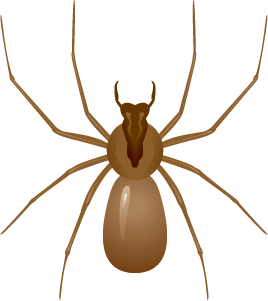Spiders
Brown Recluse Spiders

A Glimpse Into Brown Recluse Spiders
This spider prefers undisturbed places, so it typically lives in dark corners and also under furniture, boxes and books. It has a rather shy and nonaggressive behavior, although it will bite humans if it feels threatened. Its web is of a loose and irregular, yet very sticky thread. It is only built as a daytime retreat, and as an egg holder. These spiders can survive six months without food or water, hidden in its lair during daytime, roaming at night.
The most identifiable mark on the brown recluse spider is the violin shaped pattern on top of its abdomen. Differing from most spiders, which have eight eyes, recluse spiders have six eyes arranged in pairs (dyads) with one median pair and two lateral pairs.
About 50% of Brown Recluse Spider bites are ‘dry,’ meaning that no venom is injected and nothing happens to the victim. In fact, often times the victim does not even realize that he has been bit. Typically, when venom is injected, the victim will experience an immediate redness which develops around the bite then begins to disappear within a few hours. Very often, for the first 24 hours, the bite appears to be no worse than that of a mosquito; then it begins to blister in the center. Within 24 to 36 hours the blister breaks open, leaving an open, oozing ulceration.
This ulceration ‘scabs’ over within three weeks from the initial bite, leaving a permanent scar. If the bite is delivered in fatty tissue, the lesion may be very deep and extensive, not healing for over two or three years. In extreme cases where the bite is not taken care of early, skin graft, amputation, and the possibility of bone marrow failure may occur.
If you’re experiencing any problems with brown recluse spiders, call the pest control professionals at Rove: 651-967-7556. A friendly pest control expert from one of our 4 Minnesota offices (in St. Paul, Minneapolis, Oakdale & Brooklyn Park) will be able to help.
Arizona Brown Recluse Spider Control Service Areas
Massachusetts Brown Recluse Spider Control Service Areas
- Brown Recluse Spider Control in Framingham, MA
- Brown Recluse Spider Control in Marlborough, MA
- Brown Recluse Spider Control Milford, MA
- Brown Recluse Spider Control in Shrewsbury, MA
- Brown Recluse Spider Control in Southborough, MA
- Brown Recluse Spider Control in Wellesley, MA
Michigan Brown Recluse Spider Control Service Areas
- Brown Recluse Spider Control in Commerce Charter Township, MI
- Brown Recluse Spider Control in Detroit, MI
- Brown Recluse Spider Control in Farmington Hills, MI
- Brown Recluse Spider Control in Milford, MI
- Brown Recluse Spider Control in Novi, MI
- Brown Recluse Spider Control in Plymouth, MI
- Brown Recluse Spider Control in South Lyon, MI
- Brown Recluse Spider Control in Wixom, MI
Minnesota Brown Recluse Spider Control Service Areas
- Brown Recluse Spider Control in Lakeview, MN
- Brown Recluse Spider Control in Brooklyn Park, MN
- Brown Recluse Spider Control in Champlin, MN
- Brown Recluse Spider Control in Eagan, MN
- Brown Recluse Spider Control in Edina, MN
- Brown Recluse Spider Control in Golden Valley, MN
- Brown Recluse Spider Control in Inver Grove Heights, MN
- Brown Recluse Spider Control in Minneapolis-St.Paul, MN
- Brown Recluse Spider Control in Oakdale, MN
- Brown Recluse Spider Control in Plymouth, MN
- Brown Recluse Spider Control in Rochester, MN
- Brown Recluse Spider Control in Roseville, MN
- Brown Recluse Spider Control in Shoreview, MN
Wisconsin Brown Recluse Spider Control Service Areas
- Brown Recluse Spider Control in Fitchburg, WI
- Brown Recluse Spider Control in Hudson, WI
- Brown Recluse Spider Control in Madison, WI
- Brown Recluse Spider Control in McFarland, WI
- Brown Recluse Spider Control in Middleton, WI
- Brown Recluse Spider Control in Sun Prairie, WI
- Brown Recluse Spider Control in Verona, WI
